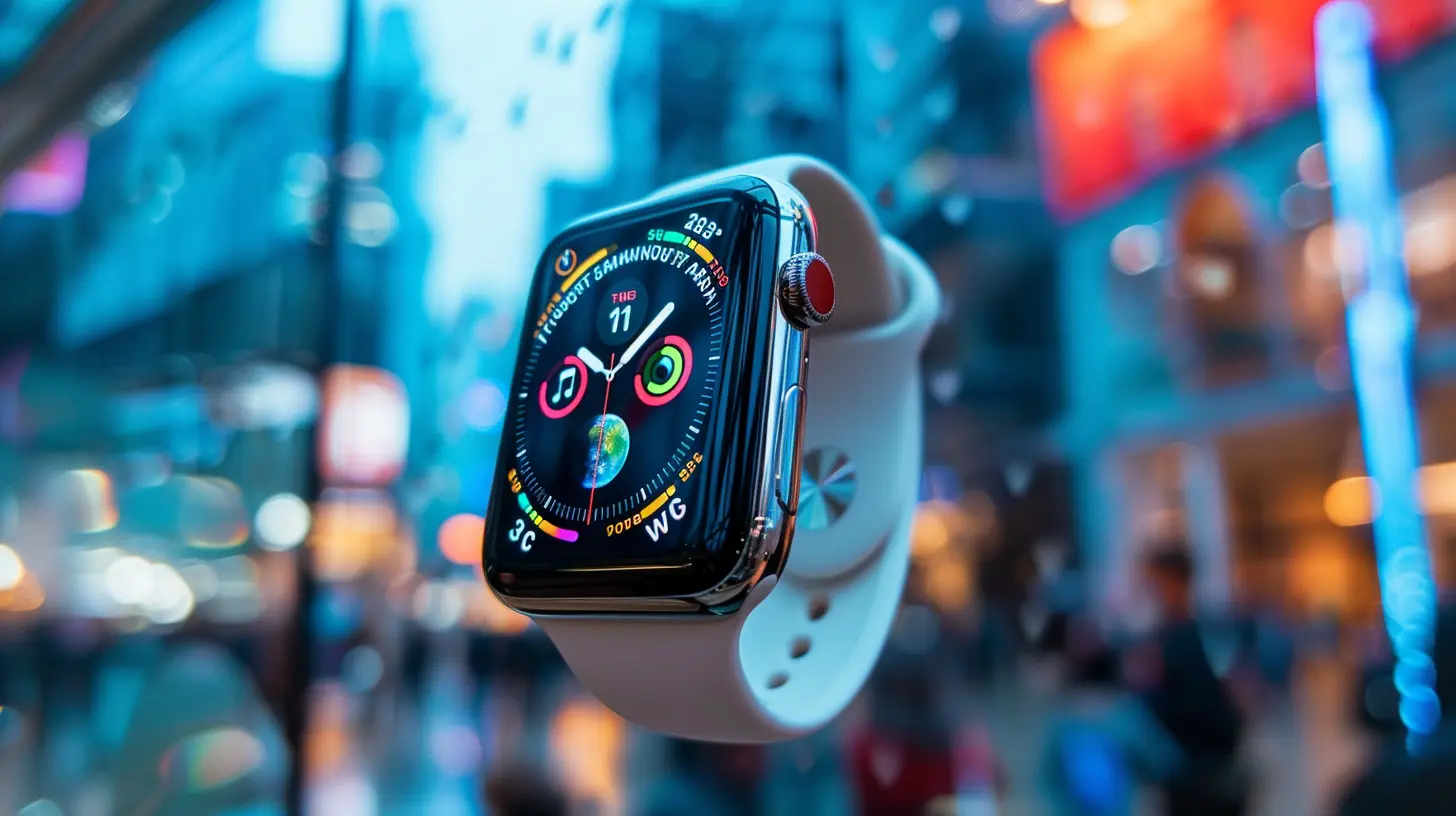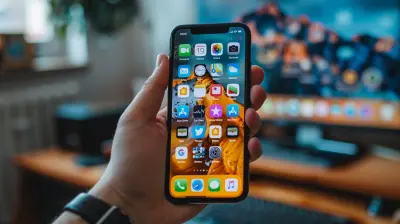The Role of Wearable Devices in Monitoring Air Quality
22 December 2024
Ever looked up at the sky on a clear day, taken a deep breath, and wondered, "Is this air as clean as it looks?" With rising concerns about pollution and its impact on our health, it's no surprise that technology has found a way to help us monitor the air we breathe. Enter wearable devices—a new frontier in personal health monitoring, and now, air quality tracking.
In the past, checking air quality was something only scientists with specialized instruments could do. But now, thanks to technology, we can all be our own air quality experts. And here's the kicker: these insights come from gadgets we already wear every day—our smartwatches, fitness bands, and other wearables.
So, let’s dive into the world of wearable devices and explore their role in helping us monitor air quality.

What Are Wearable Devices?
Before we get into the nitty-gritty of air quality, let's clarify what we mean by wearable devices. If you’ve ever worn a Fitbit or an Apple Watch, then you already own one. Wearable devices are tech gadgets you can wear on your body. These gadgets track a variety of things, from your steps to your heart rate, sleep patterns, and now—yes, you guessed it—air quality.Wearable devices have evolved rapidly in recent years. They’re no longer just fancy pedometers or calorie counters. These devices now come with sensors that can measure things we once thought were only measurable by bulky, stationary equipment. This brings us to our main point: air quality monitoring.

Why Monitor Air Quality?
Why should we care about air quality? Well, the air we breathe is essential for life, but it's also one of the most overlooked health factors. When the air is polluted, it can lead to a range of health problems—from minor irritations like coughing and sneezing to much more severe issues like asthma, lung disease, and even cardiovascular problems.In fact, according to the World Health Organization (WHO), around 7 million people die every year due to exposure to polluted air. Scary, right?
And here’s the thing: air pollution isn’t just something that happens outside in smoggy cities. Indoor air quality can also be compromised by things like mold, dust, and chemicals from household products.
Now, wouldn't it be great if you knew exactly when and where the air was bad so you could avoid it? That’s precisely where wearable air quality monitors come in.

How Do Wearable Devices Monitor Air Quality?
The technology behind air quality monitoring in wearables is downright impressive. These devices are equipped with tiny sensors that can detect fine particles and gases in the air. The two main types of pollutants that these sensors track are:1. Particulate Matter (PM): This includes tiny particles like dust, dirt, soot, and smoke. The smaller the particles, the more dangerous they are because they can penetrate deeper into your lungs. PM2.5 refers to particles with a diameter of 2.5 micrometers or less, which are particularly harmful.
2. Gaseous Pollutants: These include harmful gases like carbon dioxide (CO2), carbon monoxide (CO), ozone (O3), and volatile organic compounds (VOCs) like those emitted by paints, cleaning agents, and other household products.
Wearable devices are designed to “sniff” out these pollutants, analyze the data, and then provide you with real-time updates about the air quality around you. Some wearables even offer suggestions on how to improve the air quality in your environment or alert you when it’s time to leave a polluted area.
Key Sensors in Wearable Air Quality Monitors
- Optical Sensors: These sensors use light to detect particulate matter in the air. When particles pass through the sensor, they scatter the light, allowing the device to calculate the concentration of particles in the air.- Electrochemical Sensors: Used to detect gases like carbon monoxide or ozone, these sensors work by generating an electrical current when they come into contact with the target gas. The stronger the current, the higher the concentration of the gas.
- Temperature and Humidity Sensors: While not directly related to pollutants, temperature and humidity can influence air quality. For example, high humidity can increase mold growth indoors, which can worsen air quality.

Benefits of Wearable Air Quality Monitors
1. Personalized Data
Unlike traditional air quality monitors that give a broad, general overview of the air quality in a region, wearable devices provide personalized data that’s specific to your immediate environment. If you're walking through a park or sitting in a stuffy office, the readings will reflect the air quality where you are, not a generic city-wide average.2. Real-Time Alerts
Wearable air quality monitors give you real-time updates and alerts. Imagine going for a jog and getting a notification that the air quality is poor due to high levels of pollution. You’d then know to change your route or go indoors. This kind of instant feedback can help you make smarter decisions about your environment.3. Indoor and Outdoor Monitoring
Many wearable devices aren’t limited to just outdoor air quality monitoring. They can also track indoor air, which is important considering that the Environmental Protection Agency (EPA) estimates indoor air can be 2-5 times more polluted than outdoor air.4. Health Insights
Some wearables can even correlate air quality data with your health data. For instance, if you have asthma or allergies, these devices can help you identify patterns. You might notice that your symptoms flare up when the PM2.5 levels are high, or when you're exposed to certain VOCs.5. Empowerment
There’s something empowering about having the knowledge of what's in the air you're breathing. It gives you control. Whether it’s deciding to open a window, turning on an air purifier, or changing your location, you'll have the information you need to take action.Popular Wearable Devices for Monitoring Air Quality
1. Atmotube Pro
The Atmotube Pro is one of the most well-known wearable air quality monitors. It's small enough to clip onto your backpack or belt, and it measures PM1, PM2.5, PM10, and a range of harmful gases. The device syncs with a smartphone app to provide real-time air quality updates and even maps pollution hotspots.2. Flow 2 by Plume Labs
Flow 2 is another popular air quality monitor that’s designed for people on the go. It tracks PM2.5, PM10, nitrogen dioxide (NO2), and VOCs. It even has a sleek design that makes it look more like a trendy accessory than a piece of tech.3. TZOA
TZOA is a wearable air quality monitor that uses laser-based sensors to measure particulate matter. It also tracks UV exposure and temperature, making it a great all-around environmental health monitor.
The Future of Wearable Air Quality Monitors
The future looks bright (and hopefully cleaner) for wearable air quality monitors. As technology advances, these devices will likely become even more accurate, compact, and affordable. We may see wearables that can detect a wider range of pollutants or even forecast air quality based on patterns.Moreover, as more people start using these devices, we could see a shift in how communities address air pollution. Imagine a world where data from millions of wearables is collected to create hyper-local air quality maps, providing cities with the information they need to tackle pollution on a street-by-street level.
Challenges in Wearable Air Quality Monitoring
Of course, no technology is without its challenges. Wearable air quality monitors, while incredibly useful, are not perfect yet. Some of the key challenges include:- Accuracy: While wearables are getting better at detecting pollutants, they can’t yet match the precision of larger, stationary air quality monitoring stations.
- Battery Life: Running multiple sensors continuously can drain a device's battery quickly. Manufacturers are working to balance sensor accuracy with battery longevity.
- Cost: Some of the high-end wearable air quality monitors can be expensive, although prices are expected to come down as the technology becomes more widespread.
Conclusion
Wearable devices are transforming the way we monitor air quality. These gadgets are no longer just for tracking steps or heart rates—they’re now a valuable tool for improving our understanding of the environment around us. In a world where air pollution poses a serious threat to health, wearable air quality monitors offer a personalized, real-time solution to help us breathe easier.And let's be honest—it's pretty cool to have tech that tells us exactly what’s in the air we’re breathing, right? So, whether you're a fitness buff, a busy commuter, or someone with respiratory issues, wearable air quality monitors can be a game-changer in your daily life.
all images in this post were generated using AI tools
Category:
Wearable DevicesAuthor:

Michael Robinson
Discussion
rate this article
21 comments
Harrison McNab
Are we ready for what they might reveal?
February 10, 2025 at 4:04 AM

Michael Robinson
Absolutely, the insights from wearable devices could significantly enhance our understanding of air quality and its impact on health.
Jackson Harmon
Ah, yes! Because nothing screams 'I care about fresh air' like strapping a mini pollution monitor to my wrist while I sip my artisanal coffee indoors. Who needs outdoor adventures when you've got tech to do the worrying for you?
February 1, 2025 at 9:23 PM

Michael Robinson
Thanks for your comment! While tech can't replace outdoor experiences, it can help us stay informed about air quality, even indoors, and encourage more mindful choices for our health.
Whitney Frank
As we integrate wearable devices into our daily lives, a new realm of personal health unfolds. Could these gadgets reveal hidden dangers in the air we breathe, or are they merely echoes of a larger unseen threat?
January 28, 2025 at 1:13 PM

Michael Robinson
Wearable devices hold promise in monitoring air quality, potentially revealing hidden health risks. However, they should complement broader environmental assessments rather than replace them.
Flynn McGuffey
Wearable devices are game-changers in air quality monitoring—empowering users with real-time data. It's time to embrace technology that puts our health and environment first, unapologetically.
January 23, 2025 at 9:34 PM

Michael Robinson
Thank you! I completely agree—wearable devices truly enhance our ability to monitor air quality and prioritize health and environmental awareness. Embracing this technology is crucial for a healthier future.
Otto Perez
Empowering individuals with real-time air quality data transforms health and fosters a sustainable future!
January 21, 2025 at 3:35 AM

Michael Robinson
Thank you for your insightful comment! Empowering individuals with real-time air quality data indeed plays a crucial role in promoting health and sustainability.
Vireo McGonagle
Wearable devices are revolutionizing air quality monitoring—empowering individuals with real-time data to take charge of their health. Embrace technology; don't wait for change.
January 18, 2025 at 11:49 AM

Michael Robinson
Thank you! It's exciting to see how wearable technology empowers individuals to proactively manage their health by providing real-time air quality insights. Embracing this innovation is crucial for a healthier future.
Susan Snow
This article highlights the crucial intersection of technology and health, underscoring how wearable devices empower individuals with real-time air quality data, fostering proactive measures for personal and public well-being.
January 12, 2025 at 7:40 PM

Michael Robinson
Thank you for your insightful comment! I appreciate your recognition of how wearable devices can enhance both individual awareness and public health strategies.
Flora Nelson
Great insights! Wearable tech truly enhances our awareness of air quality.
January 8, 2025 at 5:34 AM

Michael Robinson
Thank you! I'm glad you found the insights valuable. Wearable tech indeed plays a crucial role in promoting awareness of air quality.
Jessamine Taylor
Wearable devices revolutionize personal air quality monitoring, empowering users to track exposure effectively.
January 1, 2025 at 5:20 AM

Michael Robinson
Absolutely! Wearable devices provide real-time insights, enabling individuals to actively manage their air quality exposure and make informed decisions for better health.
Ronan Barrett
Great insights on the intersection of technology and health! Wearable devices are revolutionizing air quality monitoring, empowering users with real-time data and promoting informed decisions. Excited to see how this technology evolves for better environmental awareness and personal health.
December 28, 2024 at 8:07 PM

Michael Robinson
Thank you for your insightful comment! I share your excitement about the potential of wearable devices to enhance both environmental awareness and personal health.
Kristy Hamilton
Great read! It's fascinating how wearable devices are shaping our understanding of air quality. Excited to see how technology continues to enhance our health and environment!
December 28, 2024 at 12:52 PM

Michael Robinson
Thank you! I’m glad you found it interesting. The potential of wearable tech in enhancing our awareness of air quality is indeed exciting!
Ursula Anderson
Breathe easy, tech style!
December 27, 2024 at 9:37 PM

Michael Robinson
Thank you! Wearable tech really is transforming how we interact with our environment.
Nellie McFadden
Great article! It's fascinating to see how wearable devices are evolving to not only track health metrics but also play a crucial role in monitoring air quality for enhanced environmental awareness.
December 27, 2024 at 11:54 AM

Michael Robinson
Thank you! I'm glad you found it fascinating. Wearable devices truly represent a significant advancement in promoting health and environmental awareness.
Faenor Wilkerson
Great insights on wearable tech's impact on air quality awareness!
December 26, 2024 at 5:40 AM

Michael Robinson
Thank you! I'm glad you found the insights valuable. Wearable tech really does play a crucial role in raising awareness about air quality.
Opal Hahn
Wearable devices are revolutionizing air quality monitoring by providing real-time data, enabling users to make informed health decisions. Their integration with mobile applications enhances accessibility, promoting greater awareness and proactive measures against air pollution exposure.
December 25, 2024 at 1:44 PM

Michael Robinson
Thank you for your insightful comment! Indeed, wearable devices play a crucial role in empowering individuals to understand and mitigate the impacts of air quality on their health.
Quincy Baker
Great article! It's exciting to see how wearable devices are stepping up to tackle air quality issues. With technology like this, we can all become more aware of our environment and make healthier choices. Keep up the amazing work, and let's breathe a little easier together! 🌍✨
December 25, 2024 at 5:07 AM

Michael Robinson
Thank you for your kind words! I'm glad you found the article inspiring. Together, we can indeed make a positive impact on our air quality! 🌿
Elara Forbes
Essential for real-time air quality insights!
December 24, 2024 at 9:30 PM

Michael Robinson
Thank you! Real-time insights are indeed crucial for understanding and improving air quality.
Zaid Bishop
This article highlights a crucial intersection of technology and health. Wearable devices have the potential to empower individuals by providing real-time air quality data, fostering awareness, and enabling proactive measures. However, it's essential to consider data privacy and accuracy to ensure their effective use in daily life.
December 24, 2024 at 4:10 AM

Michael Robinson
Thank you for your insightful comment! I completely agree that while wearable devices offer significant benefits for health monitoring, addressing data privacy and accuracy is vital for their successful implementation.
Piper Hurst
Finally, a way to know if my air is fresher than my morning coffee! Imagine a smartwatch that just says, 'Breathe at your own risk!' Who knew pollution could be tracked like my steps?
December 23, 2024 at 8:44 PM

Michael Robinson
Indeed, it's fascinating how wearable technology can help us monitor air quality just like we track our fitness. Knowing when to breathe safely is crucial in today's polluted world!
Maren Butler
Wearable devices offer real-time air quality insights, enhancing personal health monitoring and awareness.
December 23, 2024 at 1:33 PM

Michael Robinson
Thank you for your comment! Indeed, wearable devices play a crucial role in providing users with immediate air quality data, empowering them to make informed health choices.
Carrie McCarron
Great article! It’s fascinating to see how wearable devices can empower us to monitor air quality and make healthier choices in our daily lives!
December 22, 2024 at 1:00 PM

Michael Robinson
Thank you! I'm glad you found it interesting. Wearable devices truly empower us to make informed health choices.
MORE POSTS

Exploring the Role of Artificial Intelligence in Virtual Reality

The Best Tools for Creating Interactive Content

The Evolution of Solar Roof Tiles: A Game-Changer for Green Homes

How Robotics is Innovating the World of Sports

Solar-Powered Gadgets for Eco-Conscious Travelers

The Role of Government in Enforcing Cybersecurity Regulations

Tools for Creating Mobile-First Content That Engages Audiences

How Blockchain is Disrupting Traditional Banking
Wearable Devices for Sleep Tracking: Rest Better, Feel Better

Blockchain’s Role in Ensuring Ethical Supply Chains

Why Tech Startups Are Betting Big on Augmented Reality

Rugged Outdoor Gadgets for the Ultimate Adventure Seeker

The Rise of Women in Esports: Challenging the Status Quo